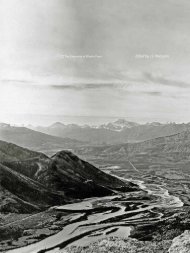C Ihe Ladies c cu. V'VVAN - History and Classics, Department of
C Ihe Ladies c cu. V'VVAN - History and Classics, Department of
C Ihe Ladies c cu. V'VVAN - History and Classics, Department of
- No tags were found...
Create successful ePaper yourself
Turn your PDF publications into a flip-book with our unique Google optimized e-Paper software.
NotestoPoges33-35 251One day we visited the hospitalSt Ann's Roman Catholic Hospital opened in 1914 <strong>and</strong> serveda huge area <strong>of</strong> the North for sixty-five years before it was closedin 1979 ("Grey"). In the 1920s, all hospitals in the NWTwereoperated by the Anglican <strong>and</strong> Roman Catholic churches(Dickerson 44-5).On Sunday we went to the ROlIlan Catholic churchSt Isidore Roman Catholic Church was built in 1923, threeyears before Vyvyan visited it.the chief, whose nalIle was SquirrelPierre Squirrel was the Slavey chief <strong>of</strong> the Fort Smith b<strong>and</strong>.According to Philip Godsell, who met him in 1920, he spokeCree as well as Slavey (Arctic 186). Local Fort Smith historian<strong>and</strong> genealogist Marie Swanson states that he was born in 1848.He married Marguerite M<strong>and</strong>eville on 28 May 1878 in FortSmith; they had eight children together, <strong>and</strong> adopted severalmore. After Marguerite's death, he became a newlywed again,when on 15 August 1924, at age seventy-six, he married AdeleMcKay in Hay River; they adopted one child. Squirrel died on4 May 1939 <strong>and</strong> is buried in the cemetery at St Isidore Church,Fort Smith. Unlike Vyvyan, who seems to find him quaint ifnot risible, Agnes Deans Cameron considered him authoritativewhen she met him in 1908 (148-49; rev. ed. II4);however, Vyvyan ac<strong>cu</strong>rately reported his appearance. KennethConibear remembers that in the 1920S "Pierre Squirrel ... didindeed usually wear a blue serge suit <strong>and</strong> a yachting cap. I thinkwe never saw him in full paint <strong>and</strong> feathers, <strong>and</strong> I do not recallever seeing him with long grey hair. He was a good, <strong>and</strong> honest,<strong>cu</strong>stomer at our store."Chief Squirrel's political role in the emerging North wasnot insignificant. In 1920, "in addition to a number <strong>of</strong> whitemen," he told F.H. Kitto that "venereal diseases were introducedto the district, <strong>and</strong> the native population contaminatedby them during the time <strong>of</strong> the Klondike rush" (Kitto,"Report" 27), <strong>and</strong> he asked Kitto to convey "his respects to thenew Commissioner <strong>and</strong> to tell him that he would like to receivea warm suit <strong>of</strong> clothes for winter wear" (29). In 1922, heinformed the Indian agent at Fort Smith <strong>of</strong> his people's alarmat the prospect <strong>of</strong>living on a reserve (Fumoleau 122). Thatsame year, he voiced the opposition <strong>of</strong> the Fort Smith - FortFitzgerald B<strong>and</strong> to any plan to create a buffalo park if itimpinged on his people's traditional hunting <strong>and</strong> trappinggrounds (Fumoleau 255). In 1928, his expression <strong>of</strong> alarmover the feared effects on his people <strong>of</strong> the federal government'shastily initiated policy <strong>of</strong> closed seasons on fur <strong>and</strong>game animals issued in an alteration to the policy (Fumoleau281 -82), a policy which the bishops <strong>of</strong> both churches, as well as<strong>Department</strong> <strong>of</strong> Indian Affairs <strong>of</strong>ficial (<strong>and</strong> poet) DuncanCampbell Scott, also opposed (Dickerson 52-3). Howeverromanticized a picture <strong>of</strong> him Vyvyan is inclined to paint,Squirrel was <strong>of</strong> the generation <strong>of</strong> native leaders who made thetransition from paint <strong>and</strong> feathers to yachting cap <strong>and</strong> othervestiges <strong>of</strong> bureaucracy.A bearded French priest preached in French <strong>and</strong> then inChipewyanRev Pere Alphonse Mansoz omi was the superieur oblat at theH6pitale Ste-Anne <strong>and</strong> Maison provinciale du Territoire duNord-Ouest from 1924 to August 1926 ("Fort SmithChroniques") .Mr Brabant arranged for a gas boat ... pulled close to aneddy below the rapids ... we l<strong>and</strong>ed on a flat pink graniteislet ... there were waves with crests flung backward againstthe <strong>cu</strong>rrent, <strong>and</strong> rocky islets in Il1id-river, each one lonely<strong>and</strong> helpless as regret.Vyvyan here conflates her account <strong>of</strong> an outing made in theboat on Saturday, 12 June-only in the middle <strong>of</strong> which did shelearn that the place where she wanted to visit to see pelicanscould be approached by boat only from Fort Fitzgerald-withher account <strong>of</strong> a walk that she took with Dorrien Smith toMountain Rapids on Tuesday, 8June; thereby, she creates themistaken impression that she is describing the rapids nearest toFort Smith. These are the Rapids <strong>of</strong> the Drowned, the sound<strong>of</strong> which had played on her ears during her stay at Fort Smith.By comparing her description <strong>of</strong> the rapids with a moredetailed one <strong>of</strong> Mountain Rapids (two sets upstream), writtenby British naval explorer George Back 106 years earlier, onesees not only Vyvyan' s narrative method but also her interest inthe same details that captured the eye <strong>of</strong> the explorer-artisttrained in the enduring English l<strong>and</strong>scape conventions <strong>of</strong> thesublime <strong>and</strong> picturesque:On crossing the Mountain Portage there is an extremelyfine view breaks upon the Sight from the hill which you areascending - The River is about 3 miles broad - perfectly
















